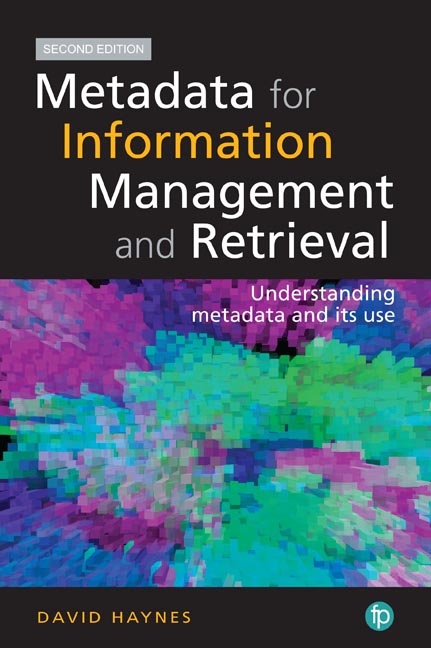Book contents
- Frontmatter
- Contents
- List of figures and tables
- Preface
- Acknowledgements
- PART I METADATA CONCEPTS
- PART II PURPOSES OF METADATA
- 5 Resource identification and description (Purpose 1)
- 6 Retrieving information (Purpose 2)
- 7 Managing information resources (Purpose 3)
- 8 Managing intellectual property rights (Purpose 4)
- 9 Supporting e-commerce and e-government (Purpose 5)
- 10 Information governance (Purpose 6)
- PART III MANAGING METADATA
- References
- Index
7 - Managing information resources (Purpose 3)
from PART II - PURPOSES OF METADATA
Published online by Cambridge University Press: 08 June 2018
- Frontmatter
- Contents
- List of figures and tables
- Preface
- Acknowledgements
- PART I METADATA CONCEPTS
- PART II PURPOSES OF METADATA
- 5 Resource identification and description (Purpose 1)
- 6 Retrieving information (Purpose 2)
- 7 Managing information resources (Purpose 3)
- 8 Managing intellectual property rights (Purpose 4)
- 9 Supporting e-commerce and e-government (Purpose 5)
- 10 Information governance (Purpose 6)
- PART III MANAGING METADATA
- References
- Index
Summary
Overview
Management of information was the third of the purposes of metadata identified in the six-point model of metadata use. This chapter describes the information lifecycle and a simplified model of this provides the framework for describing the management of information resources and the role of metadata. The chapter considers the role of metadata in each of the main stages of the information lifecycle. This is illustrated with examples from libraries, archives, records management and research data repositories.
Information lifecycles
One of the purposes of metadata is to manage the capture, storage, distribution and use of information resources. This can be done in a variety of contexts: libraries, records collections, archives, research data repositories and multimedia collections. As well as formal collections, metadata also plays an important role in the organisation of personal collections, such as bibliographic references, social media and personal files.
The concept of an information lifecycle is widely used in the management of digital resources and particularly for preservation. There are identifiable stages in the life of a digital resource and this provides a basis for managing those resources. Detlor (2010) puts forward a process-based view of information management where the number of steps in the information lifecycle depends on the perspective taken (organisational, library, or personal). This is an idea that is also summarised in Floridi's (2010) overview of Information. Although metadata does not refer exclusively to digital information (it is also used for books and other physical manifestations of information) the majority of examples discussed here are electronic. These include websites, electronic document and records management systems, data repositories and social media. The lifecycle concept is well developed in records management and this is reflected in ISO15489-1:2016, the international standard for records management, which emphasises events in the lifecycle of records:
Six broad classes of metadata may be used in the management of records. They may be applied to all entities (see above), or fewer, depending on the complexity of the implementation. The six classes are the following:
a) Identity – information to identify the entity;
b) Description – information to determine the nature of the entity;
c) Use – information that facilitates immediate and longer-term use of the entity;
d) Event plan – information used to manage the entity, such as disposition information;
- Type
- Chapter
- Information
- Metadata for Information Management and RetrievalUnderstanding metadata and its use, pp. 113 - 126Publisher: FacetPrint publication year: 2018



